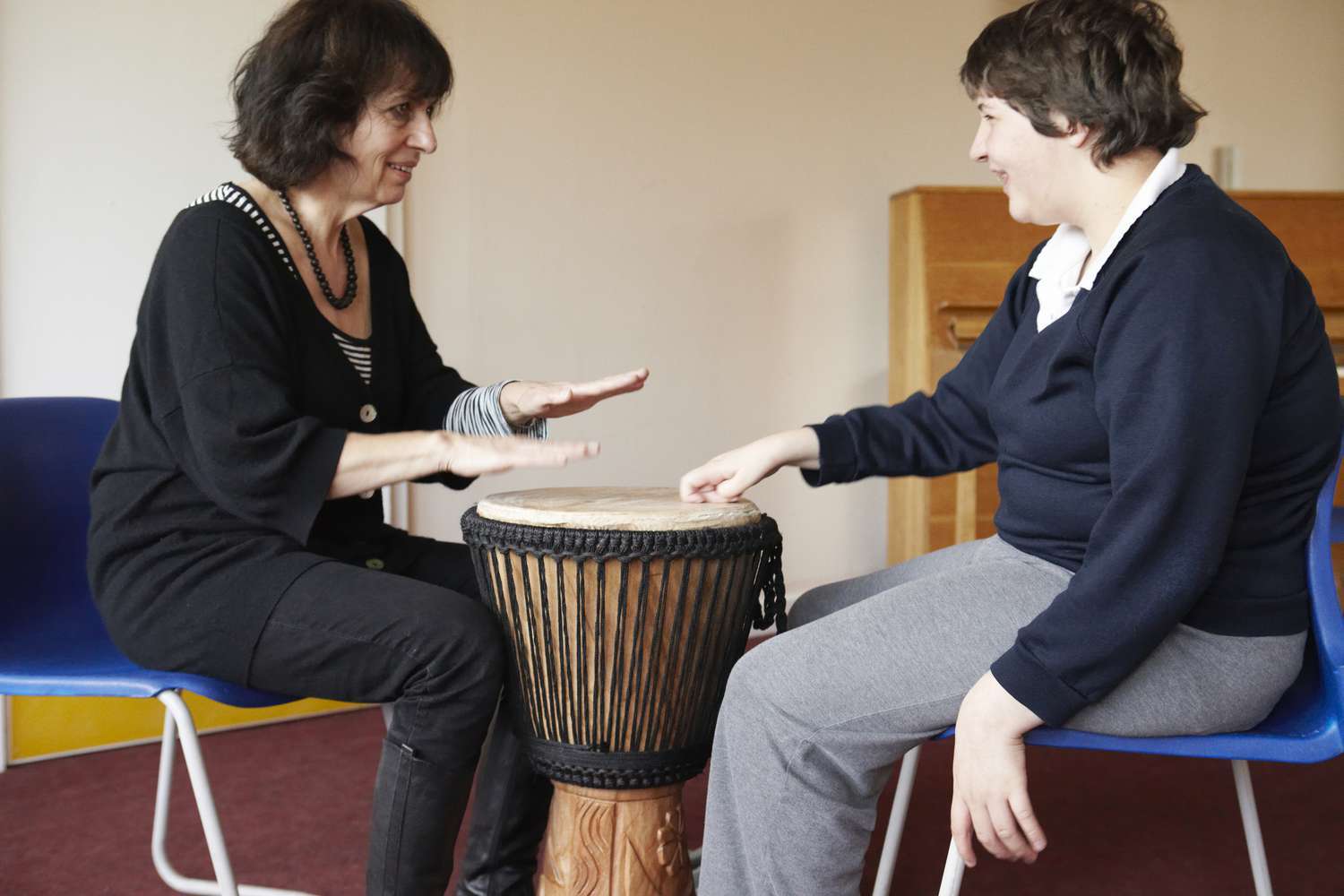Music therapy is a well-established and risk-free technique for using musical interaction to help individuals with a wide range of cognitive and emotional challenges to improve their ability to function. By interacting with adults and children on the autism spectrum, musical therapists can build skills, lower anxiety, and even develop new communication skills.
:max_bytes(150000):strip_icc()/GettyImages-108142850-253395e766364b4688c55f82586c40c1.jpg)
Tina Stallard / Getty Images
It’s important to note that music therapy is not the same as musical instruction. If your aim is to have your child build vocal or instrumental skills, you’ll need to find an instructor instead of or in addition to a music therapist.
Why Music Therapy Might Be a Good Choice
Music therapy may help people with autism to improve skills in areas such as communication, social skills, sensory issues, behavior, cognition, perceptual/motor skills, and self-reliance or self-determination. The therapist finds music experiences that strike a chord with a particular person, making personal connections and building trust.
According to a meta-study that looked at outcomes, “Reported benefits included, but were not limited to increased appropriate social behavior; increased attention to task; increased vocalization, verbalization, gesture, and vocabulary comprehension; increased communication and social skills; enhanced body awareness and coordination; improved self-care skills; and reduced anxiety.” Another study suggests that family-centered music therapy can build stronger parent-child bonds.
People on the autism spectrum are often especially interested in and responsive to music. Because music is motivating and engaging, it may be used as a natural “reinforcer” for desired responses. Music therapy can also help those with sensory aversions to certain sounds to cope with sound sensitivities or individual differences in auditory processing.
If your child already seems to enjoy and respond to music, it may be worth your while to look into music therapy providers.
What Does a Music Therapist Do for People With Autism?
After assessing the strengths and needs of each person, music therapists develop a treatment plan with goals and objectives and then provide appropriate treatment. Music therapists work with both individuals and in small groups, using a variety of music and techniques. A good music therapist should be able to develop strategies that can be implemented at home or at school.
How to Find a Board Certified Music Therapist
Music therapists must earn a bachelor’s degree or higher in music therapy from an American Music Therapy Association (AMTA) approved college and university program; complete a minimum of 1,200 hours of clinical training; and pass a national examination administered by the Certification Board for Music Therapists (CBMT) to obtain the credential required for professional practice, Music Therapist-Board Certified (MT-BC).
Some music therapists work in school settings as a related service on a child’s Individual Education Plan (IEP), either hired or contracted by a school district. Others have private practices or work for agencies that specialize in treatment for individuals with developmental disabilities. Some states fund music therapy services through Medicaid Waivers or other state programs. Private health insurance reimbursement usually requires pre-approval on a case-by-case basis.
What is music therapy?
There are many different types of music therapy. For autistic people, music therapy uses interactive musical activities to improve social and communication skills.
Who is music therapy for?
Music therapy is for anyone of any age or ability.
What is music therapy used for?
Music therapy is used to improve social and communication skills.
Where does music therapy come from?
Music therapy was first used for children with additional needs in the early to mid-1900s in the United States. Its use became more widespread in the 1950s and 1960s in the United Kingdom.
Music therapy for autistic children developed as a way to help these children with social interaction and communication.
What is the idea behind music therapy?
For people who can’t easily communicate, music therapy can be a way of communicating and interacting. Instead of using words to communicate, people can use a range of musical activities – singing, playing instruments, improvising, songwriting and listening to music. These activities promote communication and social skills like making eye contact, sharing attention and taking turns.
Therapists can also use musical activities to teach new skills. This happens by pairing new skills with their own musical cues. Once children have learned the skills, they no longer need the cues. The cues are gradually phased out until the skills happen by themselves.
For an autistic child, a music therapist might also write lyrics about specific behaviour – for example, turn-taking. The therapist sings the lyrics to the melody of a song the child knows well. The idea is that the child might be better able to focus on sung information than spoken information.
What does music therapy involve?
Music therapy typically involves the following stages:
- Assessment: the therapist assesses a child to find out the child’s needs. Because music therapy is often used along with other autism therapies, the therapist might also consult the child’s GP or other therapists.
- Goal-setting: an individualised program is developed based on the child’s needs.
- Activities: sessions consist of activities designed to meet the child’s individual needs. These could include songwriting, moving to music, singing, playing instruments, listening to music, working in groups and improvising.
- Evaluation: the program is regularly evaluated to make sure it’s working well.
Music therapy sessions can be one on one or in a group.
Children typically attend once a week for about 20-50 minutes. The duration of the therapy depends on children’s needs.
Does music therapy help autistic children?
Research has shown that music therapy can help children develop or improve skills like shared attention, communication and play. It might help autistic children and children with intellectual disabilities more than typically developing children.
Who practises music therapy?
Registered music therapists practise music therapy. A registered music therapist is someone who has completed an accredited training program and is registered with the Australian Music Therapy Association.
Music therapists work in a range of organisations including specialist schools, nursing homes, early intervention centres and mental health facilities. They also work in private practice.
Many therapists work with specific groups of people, so not all will have experience in working with autistic people. You’ll need to check the experience of any therapist you choose to work with.
Where can you find a practitioner?
You can find a registered music therapist on the Australian Music Therapy Association website.
If you’re interested in music therapy, it’s a good idea to talk about it with your GP or one of the other professionals working with your child. You could also talk about it with your NDIA planner, early childhood partner or local area coordinator (LAC), if you have one.
Parent education, training, support and involvement
You don’t need to do any training for this approach.
Cost considerations
The cost per session varies and depends on the therapist.
You might be able to include the cost of music therapy in children’s NDIS plans. You can contact the NDIS to find out.
Therapies and supports for autistic children range from behaviour therapies and developmental approaches to medicines and alternative therapies. When you understand the main types of therapies and supports for autistic children, it’ll be easier to work out the approach that will best suit your child.

Music has always had a therapeutic effect on people, and even more so for individuals diagnosed with autism, especially children. Its calming effects have been well established within the medical community, helping to ease their integration into society.

Music is often used as a supplement when they are learning verbal communication skills, as it provides an entirely different way for children with autism to express themselves.
Having another channel of communication can sometimes be vital to increasing the intimacy between parents and their children with autism. Also, kids on the autism spectrum are exceptionally responsive to musical stimuli, and it can be used to reinforce desired responses from them.
The surprising connection between music and autism
There has been a vast amount of research showing that music has many benefits for children with autism. While autistic individuals are slower to develop speech communication skills, they are able to understand music equally well, if not better than individuals who do not have autism.
While autism can affect an individual to different degrees, music therapy is consistently beneficial across the entire spectrum of autism.
To be specific, autistic children have an enhanced ability to recognize pitch, memorize tunes, and map emotions onto musical pieces. In some specific individuals, they have been able to master playing the piano fluently even before they can speak complete sentences.
Why might music therapy be a good choice for your child?
Music has been shown in schools to improve responses in autistic children. Studies reveal that autistic kids respond much more frequently than usual during music lessons. Music not only motivates them to respond more often but also helps them to enjoy the process of expressing themselves.

If we look closer at how a musical band works, it can reveal exactly why music therapy can be beneficial to autistic children. A band involves different instruments working and coordinating with each other to produce a unified tune, yet only requires an individual player to focus on one instrument at first.
The gradual coordination between different instruments is not unlike how normal individuals coordinate their senses in their everyday lives. This is exactly what an autistic child finds hard to do, so learning through music can gradually help them understand and improve their cognitive coordination skills.
How is music therapy used for kids with autism?
One of the common ways to include music in learning is for autistic kids to engage in musical improvisation, where a therapist demonstrates how to use an instrument, followed by allowing autistic kids to play the instruments in any way they like. As there is no such thing as a mistake in improvisation, therapists can continuously encourage and build their confidence in expressing themselves through a musical instrument.
Another way to use music in therapy is to let them memorize and repeat simple songs, which can be much easier for them to master than speech. Studies have also shown that simple classical tunes have the best effect in calming autistic kids, and eventually, through playing these in the background in their daily lives, they can improve their control on their own mood and temperament.
The benefits of music for autism
Music can confer many benefits to autistic individuals. First among these is improved communication. Parents and caregivers have found that autistic children are able to communicate and express themselves much better through music than any other form of expression. This can sometimes be in the form of singing, as an alternative to speech.
Music can also improve a child’s behavior, as it has a calming effect on them. This has been shown to result in reduced anxiety, aggression, and tension. This connection is rooted in neuroscience, where hearing and motor functions are controlled in the same parts of the brain. While autistic kids experience external stimuli differently than most people, music therapy trains them to separate and focus on specific stimuli, which can even improve the way they communicate verbally.
Music is also a multi-sensory activity, which simultaneously requires one to listen, watch, and touch a musical instrument, and this creates an opportunity to train and fine-tune their motor skills.
Finally, music can help in social interaction, as children communicate through passing and sharing musical instruments, listening, and singing.
Closing thoughts
Music is an engaging and enjoyable activity that can bring about positive behavioral changes over a long period of prolonged music therapy sessions. Just like most other forms of play learning, music therapy for autistic children can be engaging without being tedious. It is an extremely effective way for parents to reach out and communicate with their autistic kids, even when nothing else can. Most of all, music is fun!
Always bear in mind that consistency is key, and perseverance with any particular therapy, including musical therapy, is vital to yielding good results.
If your child has benefitted from music therapy, we’d love to hear from you!
This is a guest post by Sage Music.
Curtis Dean writes on behalf of Sage Music School where they base lessons on the science and research of the psychology of learning. Their effective teaching methods create confident and capable students who enjoy the happiness of making music.
Social media links:
https://www.facebook.com/SageMusicCo
https://twitter.com/sagemusicco
https://in.linkedin.com/company/sage-music




